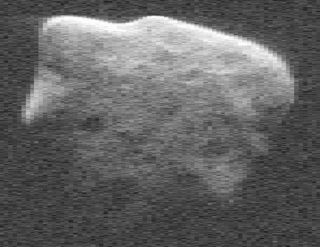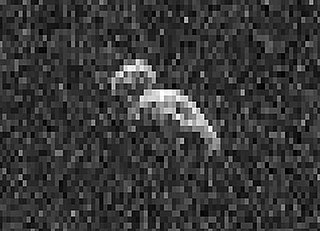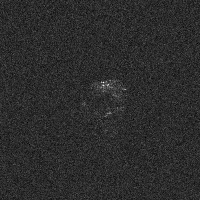Related Research Articles
4486 Mithra, is an eccentric asteroid and suspected contact-binary, classified as near-Earth object and potentially hazardous asteroid, approximately 2 kilometers in diameter. It belongs to the Apollo group of asteroids and is a relatively slow rotator.

(53319) 1999 JM8 is an asteroid, slow rotator and tumbler, classified as a near-Earth object and potentially hazardous asteroid (PHA) of the Apollo group, approximately 7 kilometers (4 miles) in diameter, making it the largest PHA known to exist. It was discovered on 13 May 1999, by astronomers of the Lincoln Near-Earth Asteroid Research at the Lincoln Laboratory's Experimental Test Site near Socorro, New Mexico.
8034 Akka, provisional designation 1992 LR, is a sub-kilometer sized, eccentric asteroid and near-Earth object of the Apollo group, approximately 540 meters in diameter. It was discovered at Palomar Observatory in 1992, and named after Akka from Finnish mythology.
3102 Krok, provisional designation 1981 QA, is a rare-type asteroid and slow rotator, classified as a near-Earth object of the Amor group, that measures approximately 1.5 kilometers in diameter.
3288 Seleucus, provisional designation 1982 DV, is a rare-type stony asteroid, classified as near-Earth object of the Amor group of asteroids, approximately 2.5 kilometers in diameter. It was discovered on 28 February 1982, by German astronomer Hans-Emil Schuster at ESO's La Silla Observatory site in northern Chile. It was named after the Hellenistic general and Seleucid ruler Seleucus I Nicator.

2010 TD54 is a tiny asteroid and fast rotator, classified as a near-Earth object of the Apollo group, approximately 5 meters in diameter. It was first observed by the Mount Lemmon Survey in October 2010, when the asteroid crossed through the Earth-moon system and had a close encounter with Earth.

(388188) 2006 DP14, provisional designation 2006 DP14, is a sub-kilometer sized, peanut-shaped asteroid on a highly eccentric orbit, classified as near-Earth object and potentially hazardous asteroid of the Apollo group. This contact binary was discovered on 23 February 2006, by astronomers of the LINEAR program at the Lincoln Laboratory's Experimental Test Site near Socorro, New Mexico, in the United States. On 10 February 2014, it passed 6.25 lunar distances from Earth. The asteroid is approximately 400 meters in diameter and has a rotation period of 5.77 hours.

2014 RC is a sub-kilometer near-Earth object and Apollo asteroid. The exceptionally fast rotator passed within 0.000267 AU (39,900 km; 24,800 mi) (0.1 lunar distances) of Earth on 7 September 2014. The asteroid is approximately the diameter of the Chelyabinsk meteor, and passed almost as close to Earth as 367943 Duende (2012 DA14) did in 2013.
(391211) 2006 HZ51 is a bright, sub-kilometer asteroid on an eccentric orbit, classified as a near-Earth object and a potentially hazardous asteroid of the Amor group. It was discovered on 27 April 2006, by astronomers of the Catalina Sky Survey conducted at Mount Lemmon Observatory, Arizona, United States. During preliminary observations, it was thought to have a small chance of impacting Earth in 2008. The asteroid measures approximately half a kilometer in diameter and has an exceptionally high albedo.
(456938) 2007 YV56, provisional designation 2007 YV56, is a sub-kilometer asteroid on an eccentric orbit, classified as a near-Earth object and potentially hazardous asteroid of the Apollo group, approximately 190–360 meters (620–1,200 ft) in diameter. It was discovered on 31 December 2007, by astronomers of the Catalina Sky Survey conducted at the Catalina Station in Arizona, United States.
2015 HM10 is an irregular shaped asteroid and sub-kilometer near-Earth object that passed near the Earth on 7 July 2015, at a distance of 442,000 kilometers or 1.15 lunar distances.

(436724) 2011 UW158, provisionally known as 2011 UW158, is a stony, walnut-shaped asteroid and fast rotator, classified as near-Earth object and potentially hazardous asteroid of the Apollo group, approximately 300 meters in diameter. It was discovered on 25 October 2011, by Pan-STARRS at Haleakala Observatory on the island of Maui, Hawaii, in the United States.
(159857) 2004 LJ1, provisional designation 2004 LJ1, is an asteroid on an eccentric orbit, classified as near-Earth object and potentially hazardous asteroid of the Apollo group, approximately 3 kilometers in diameter. The asteroid was discovered on 10 June 2004, by astronomers of the LINEAR program at Lincoln Laboratory's Experimental Test Site near Socorro, New Mexico, in the United States. It is one of the largest potentially hazardous asteroids known to exist.
(85713) 1998 SS49 (provisional designation 1998 SS49) is an asteroid on an eccentric orbit, classified as near-Earth object and potentially hazardous asteroid of the Apollo group, approximately 3 kilometers (1.9 miles) in diameter. The asteroid was discovered on 29 September 1998, by astronomers of the LINEAR program at Lincoln Laboratory's Experimental Test Site near Socorro, New Mexico, in the United States. It is one of the largest potentially hazardous asteroids and has a notably low Earth-MOID of less than the distance to the Moon.
(111253) 2001 XU10 (provisional designation 2001 XU10) is an asteroid on an eccentric orbit, classified as near-Earth object and potentially hazardous asteroid of the Apollo group, approximately 3 kilometers in diameter. It was discovered on 9 December 2001, by astronomers of the LINEAR program at Lincoln Laboratory's Experimental Test Site near Socorro, New Mexico, in the United States. The asteroid is one of the largest potentially hazardous asteroids.

(505657) 2014 SR339, provisional designation 2014 SR339, is a dark and elongated asteroid, classified as near-Earth object and potentially hazardous asteroid of the Apollo group, approximately 970 meters (3,200 feet) in diameter. It was discovered on 30 September 2014, by NASA's Wide-field Infrared Survey Explorer telescope (WISE) in Earth's orbit. Closely observed at Goldstone and Arecibo in February 2018, it has a rotation period of 8.7 hours.

2018 DV1 is a micro-asteroid, classified as a near-Earth object of the Aten group, approximately 6–12 meters (20–40 feet) in diameter. It was first observed on 26 February 2018, by astronomers of the Mount Lemmon Survey at Mount Lemmon Observatory, Arizona, five days prior to its sub-lunar close encounter with Earth at less than 0.3 lunar distance.
(85182) 1991 AQ is a stony asteroid on a highly eccentric orbit, classified as near-Earth object and potentially hazardous asteroid of the Apollo group, approximately 1.1 kilometers in diameter. It was discovered on 14 January 1991, by American astronomer Eleanor Helin at the Palomar Observatory in California. Based on its brightness variation of 0.69 magnitude, this Q-type asteroid is likely elongated. It belongs to the small group of potentially hazardous asteroids larger than one kilometer.
(154276) 2002 SY50, provisional designation 2002 SY50, is a stony asteroid on a highly eccentric orbit, classified as near-Earth object and potentially hazardous asteroid of the Apollo group, approximately 1.1 kilometers (0.7 miles) in diameter. It was discovered on 30 September 2002, by astronomers with the Lincoln Near-Earth Asteroid Research at the Lincoln Laboratory's Experimental Test Site near Socorro, New Mexico, in the United States. The K-type asteroid has a rotation period of 4.8 hours. It will make a close encounter with Earth on 30 October 2071.

2016 DV1 is a near-Earth asteroid estimated to be roughly 29–65 meters (95–210 feet) in diameter. It is a fast rotating asteroid of the Apollo group which was first observed by the Mount Lemmon Survey on 28 February 2016, just days before it passed Earth at 1 lunar distance (LD) on 3 March 2016. The elongated fast rotator has a rotation period of 303 seconds. It was recovered in February 2021 as it was about to pass Earth on 3 March 2021 at a distance of 0.0053 AU (2.1 LD; 790,000 km; 490,000 mi).
References
- 1 2 3 4 5 6 7 "2001 AV43". Minor Planet Center. Retrieved 2 November 2018.
- 1 2 3 4 5 6 7 8 9 "JPL Small-Body Database Browser: (2001 AV43)" (2013-11-24 last obs.). Jet Propulsion Laboratory . Retrieved 2 November 2018.
- 1 2 3 4 5 6 7 8 9 "LCDB Data for 2001 AV43". Asteroid Lightcurve Database (LCDB). Retrieved 24 January 2018.
- 1 2 3 Whiteley, R. J.; Hergenrother, C. W.; Tholen, D. J. (November 2002). "Monolithic fast-rotating asteroids". Proceedings of Asteroids. 500: 473–480. Bibcode:2002ESASP.500..473W . Retrieved 24 January 2018.
- ↑ Jim Borg (16 November 2013). "Asteroid to make 'close' pass to Earth on Monday". Star Advertiser.